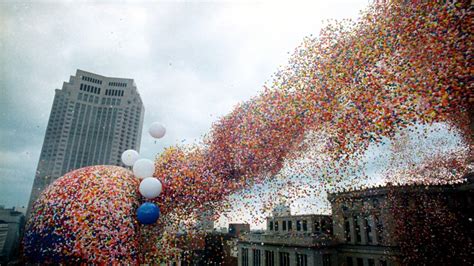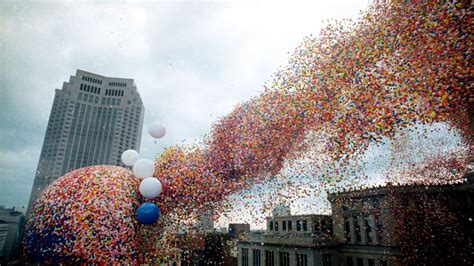
A 1986 Cleveland publicity stunt involving the release of nearly 1.5 million balloons turned disastrous, causing widespread environmental and economic disruption, and continues to serve as a cautionary tale about the unintended consequences of large-scale events. The event, dubbed “Balloonfest ’86,” aimed to break a world record and promote United Way, but instead unleashed a cascade of problems that included grounded air traffic, a hampered search-and-rescue operation, and significant property damage.
Balloonfest ’86, conceived as a visually stunning spectacle, quickly spiraled into a logistical and environmental nightmare. The event, held on September 27, 1986, in downtown Cleveland, was initially intended to be a celebratory and philanthropic achievement. However, a combination of unforeseen weather conditions and the sheer scale of the undertaking led to its downfall. The original goal was to release over two million balloons, but approximately 1.4 million were launched due to rising concerns about the weather.
United Way of Cleveland, struggling with fundraising targets, envisioned the event as a way to boost visibility and donations. They partnered with a Los Angeles-based company specializing in large-scale balloon releases. Preparations involved hundreds of volunteers who spent countless hours inflating the balloons inside a massive netting structure erected on Public Square. The ambition was clear: to create an unforgettable spectacle that would capture the world’s attention and generate significant goodwill.
However, the weather forecast on the day of the event was far from ideal. A storm front was moving toward Cleveland, bringing with it rain and strong winds. Despite the looming threat, organizers decided to proceed with the release, fearing that postponing or canceling the event would result in significant financial losses and logistical complications.
As the balloons were released, they quickly became caught in the wind and were dispersed across Northeast Ohio. Instead of floating gracefully into the sky, they were blown back towards the city and surrounding areas. The sheer volume of balloons created numerous problems. Burke Lakefront Airport was forced to temporarily shut down as balloons filled the airspace, posing a hazard to aircraft. Roads and highways became littered with deflated balloons, creating hazardous driving conditions.
One of the most tragic consequences of Balloonfest ’86 was its interference with a search-and-rescue operation. Just hours before the balloon release, two fishermen had gone missing on Lake Erie. As the Coast Guard and other agencies initiated a search, the lake surface became covered with balloons, making it nearly impossible to spot the missing men. While the balloons weren’t directly blamed for their deaths, the balloon debris severely hampered rescue efforts. The families of the missing fishermen later filed lawsuits against United Way and the event organizers.
Beyond the immediate safety concerns, Balloonfest ’86 also caused significant environmental damage. The deflated balloons landed in fields, waterways, and forests, posing a threat to wildlife. Animals can ingest the latex balloons, mistaking them for food, which can lead to digestive problems and even death. The long-term environmental impact of the event continues to be a subject of concern, as latex can take years to decompose and can leach harmful chemicals into the soil and water.
The financial repercussions of Balloonfest ’86 were also substantial. In addition to the lawsuits filed by the families of the missing fishermen, local businesses and property owners reported damages caused by the balloons. Cleanup efforts required significant resources, and the event ultimately failed to generate the anticipated economic benefits for the city.
In the aftermath of Balloonfest ’86, the event became a symbol of the potential pitfalls of large-scale publicity stunts. It highlighted the importance of considering environmental and safety factors when planning such events and served as a reminder that even well-intentioned projects can have unintended and devastating consequences. The event led to increased awareness of the environmental impact of balloon releases and contributed to a growing movement to ban or restrict such activities.
The legacy of Balloonfest ’86 extends beyond the immediate aftermath. The event has been studied and analyzed by environmental groups, event planners, and public safety officials. It serves as a case study in risk management, highlighting the need for thorough planning, contingency measures, and a comprehensive understanding of potential environmental and social impacts.
Balloonfest ’86 also sparked a broader conversation about the ethics of large-scale events and the responsibility of organizers to prioritize public safety and environmental protection over publicity and profit. The event has been cited in numerous discussions about the need for stricter regulations and greater accountability in the event planning industry.
Despite the negative outcomes, Balloonfest ’86 also led to some positive changes. It raised awareness of the environmental impact of balloon releases and contributed to a growing movement to promote more sustainable and responsible event practices. Many organizations and communities have since adopted policies to discourage or ban balloon releases, opting instead for alternative forms of celebration and fundraising.
The cautionary tale of Balloonfest ’86 continues to resonate today, reminding us of the importance of considering the full range of potential consequences when planning and executing large-scale events. It underscores the need for a balanced approach that prioritizes public safety, environmental protection, and ethical considerations. The story serves as a powerful reminder that even the most ambitious and well-intentioned projects can have unintended and devastating consequences if not carefully planned and executed.
The event highlights the complexities of managing large-scale events and the potential for unforeseen circumstances to derail even the most meticulously planned projects. It underscores the importance of adaptability, responsiveness, and a willingness to prioritize safety and environmental concerns over other considerations.
The legacy of Balloonfest ’86 is a complex and multifaceted one. It is a story of ambition, innovation, and ultimately, failure. It is a reminder of the power of nature, the importance of planning, and the need for a responsible and ethical approach to event management. It is a cautionary tale that continues to resonate today, serving as a valuable lesson for event planners, public officials, and anyone involved in organizing large-scale events.
The disaster also underscored the ethical considerations involved in using public spaces for private gain. While United Way’s intentions were philanthropic, the event’s negative externalities—the environmental damage, the disruption of air traffic, and the interference with the search-and-rescue operation—raised questions about the extent to which private entities should be allowed to utilize public resources for promotional purposes without fully accounting for potential risks and consequences.
Moreover, the event brought attention to the lack of regulatory frameworks governing large-scale balloon releases. At the time, there were few, if any, specific laws or regulations addressing the potential environmental and safety hazards associated with such activities. Balloonfest ’86 helped to catalyze a movement towards greater regulation, with many states and localities subsequently enacting laws to restrict or ban mass balloon releases.
The event also serves as a case study in crisis communication. United Way’s response to the disaster was widely criticized for being slow and inadequate. The organization initially downplayed the severity of the situation and failed to adequately address the concerns of the public and the media. This lack of transparency and accountability further damaged the organization’s reputation and underscored the importance of having a well-defined crisis communication plan in place.
The story of Balloonfest ’86 is also a testament to the power of public memory. Despite occurring more than three decades ago, the event continues to be remembered and discussed, not only in Cleveland but also across the country and around the world. It has become a part of the city’s collective identity, a symbol of both its ambition and its vulnerabilities. The event serves as a constant reminder of the need to learn from past mistakes and to strive for a more responsible and sustainable future.
The incident also highlights the importance of risk assessment and mitigation in event planning. Organizers failed to adequately anticipate and prepare for the potential consequences of releasing such a large number of balloons. They underestimated the impact of weather conditions, the potential for environmental damage, and the possibility of interfering with emergency services. This lack of foresight proved to be a costly mistake, with far-reaching consequences.
In retrospect, Balloonfest ’86 can be seen as a watershed moment in the history of event planning. It marked a shift away from the purely promotional and celebratory aspects of events towards a greater emphasis on safety, sustainability, and social responsibility. The event helped to establish new standards and best practices for the industry, emphasizing the need for thorough planning, risk management, and stakeholder engagement.
The event also underscores the importance of considering the potential impact of events on vulnerable populations. The families of the missing fishermen were particularly affected by the disaster, as the balloon release hampered the search efforts and added to their grief and suffering. This highlights the need to consider the needs and concerns of all stakeholders, especially those who may be disproportionately affected by an event.
Balloonfest ’86 serves as a powerful reminder of the interconnectedness of human activities and the environment. The event demonstrated that even seemingly harmless actions can have significant and far-reaching consequences for the natural world. It underscores the importance of adopting a holistic and systems-thinking approach to event planning, considering the potential impact on all aspects of the environment, from air and water quality to wildlife habitats and ecosystems.
The event also highlights the role of media in shaping public perceptions of events. The media coverage of Balloonfest ’86 was largely negative, focusing on the disaster’s environmental and safety consequences. This negative publicity further damaged the reputation of United Way and the event organizers, and underscored the importance of managing media relations effectively.
In conclusion, Balloonfest ’86 is a complex and multifaceted story that offers valuable lessons for event planners, public officials, and anyone involved in organizing large-scale events. It underscores the importance of considering the full range of potential consequences, prioritizing public safety and environmental protection, and adopting a responsible and ethical approach to event management. The event serves as a powerful reminder that even the most ambitious and well-intentioned projects can have unintended and devastating consequences if not carefully planned and executed. The lessons learned from Balloonfest ’86 continue to resonate today, shaping the way events are planned and managed around the world. The disaster underscores the need for humility, foresight, and a commitment to continuous learning and improvement in the field of event planning. The event also serves as a reminder of the power of collective action and the importance of holding event organizers accountable for their actions. The legacy of Balloonfest ’86 is a legacy of both tragedy and transformation, a cautionary tale that continues to inspire positive change in the event planning industry.
Frequently Asked Questions (FAQ):
1. What was Balloonfest ’86? Balloonfest ’86 was a public relations event organized by United Way of Cleveland in September 1986. The event involved releasing nearly 1.5 million helium-filled balloons with the aim of breaking a world record and raising funds for the organization.
2. What went wrong during Balloonfest ’86? Several factors contributed to the event’s failure. Unfavorable weather conditions, including an approaching storm front with rain and strong winds, caused the balloons to be blown back towards the city. This resulted in the closure of Burke Lakefront Airport, traffic hazards, environmental pollution, and interference with a search-and-rescue operation on Lake Erie.
3. How did Balloonfest ’86 impact the search-and-rescue operation on Lake Erie? Just before the balloon release, two fishermen went missing on Lake Erie. The massive number of balloons floating on the lake’s surface significantly hampered the Coast Guard’s search efforts, making it difficult to spot the missing men. The families of the fishermen later filed lawsuits.
4. What were the environmental consequences of Balloonfest ’86? The event resulted in widespread environmental damage. The deflated balloons landed in fields, waterways, and forests, posing a threat to wildlife. Animals can ingest the latex balloons, mistaking them for food, which can lead to digestive problems and death. The decomposing latex can also leach harmful chemicals into the environment.
5. What lessons can be learned from Balloonfest ’86? Balloonfest ’86 serves as a cautionary tale about the importance of thorough planning, risk assessment, and consideration of environmental and safety factors when organizing large-scale events. It highlights the potential for unintended consequences and the need for responsible and ethical event management. The event led to increased awareness of the environmental impact of balloon releases and contributed to a growing movement to ban or restrict such activities.
Expanded In-depth Analysis and Context
The story of Balloonfest ’86 is more than just a tale of a publicity stunt gone wrong; it is a complex narrative that touches upon themes of ambition, environmental responsibility, technological limitations of the time, and the ethical considerations of large-scale events. To fully appreciate the scope of the disaster and its lasting impact, it is necessary to delve into the historical context, the motivations behind the event, and the specific factors that transformed a well-intentioned plan into a series of unfortunate events.
The Historical Context:
The mid-1980s were a period of economic transition and social change in the United States. Cities like Cleveland, once industrial powerhouses, were grappling with deindustrialization, population decline, and rising unemployment. In this context, organizations like United Way were under increasing pressure to raise funds and provide essential services to communities in need. Large-scale events and publicity stunts were often seen as a way to generate visibility and attract donors. The ambition to break a world record, as was the case with Balloonfest ’86, was a common strategy to capture media attention and boost fundraising efforts.
Motivations and Planning:
United Way of Cleveland, facing challenges in meeting its fundraising goals, sought a high-profile event that would generate significant media coverage and attract donations. The idea of releasing a massive number of balloons to break a world record was seen as an innovative and visually appealing way to achieve these objectives. The organization partnered with a Los Angeles-based company specializing in large-scale balloon releases, indicating a degree of professional planning and expertise.
Preparations for the event involved a significant logistical undertaking. Hundreds of volunteers spent weeks inflating the balloons inside a large netting structure erected on Public Square. The scale of the operation was unprecedented, and the organizers faced numerous challenges in coordinating the efforts of volunteers, securing the necessary permits, and managing the logistics of inflating, containing, and releasing such a massive number of balloons.
The Role of Technology and Weather:
In 1986, weather forecasting technology was not as advanced as it is today. While meteorologists could provide general predictions, the ability to accurately forecast localized weather patterns and microclimates was limited. The organizers of Balloonfest ’86 were aware of the approaching storm front, but they may have underestimated its potential impact on the balloon release. The decision to proceed with the event despite the weather warnings proved to be a critical error.
The sheer volume of balloons released also created unforeseen problems. The balloons, once airborne, became subject to the forces of wind and weather. The storm front pushed the balloons back towards the city and surrounding areas, causing them to accumulate in large numbers over Lake Erie, highways, and residential areas.
The Environmental Impact in Detail:
The environmental consequences of Balloonfest ’86 were significant and far-reaching. The deflated balloons, made of latex, posed a threat to wildlife. Animals such as birds, turtles, and marine mammals can ingest the balloons, mistaking them for food. This can lead to digestive blockages, starvation, and ultimately, death.
The latex balloons also take a long time to decompose, and as they break down, they can release harmful chemicals into the environment. These chemicals can contaminate soil and water, posing a threat to plant life and aquatic ecosystems. The long-term environmental impact of Balloonfest ’86 is difficult to quantify precisely, but it is clear that the event had a significant and lasting negative effect on the environment.
The Search-and-Rescue Operation and Legal Repercussions:
The interference of the balloons with the search-and-rescue operation on Lake Erie was one of the most tragic aspects of the Balloonfest ’86 disaster. The balloons made it extremely difficult for the Coast Guard and other agencies to search for the missing fishermen, potentially delaying their rescue. The families of the fishermen filed lawsuits against United Way and the event organizers, alleging negligence and claiming that the balloon release had hampered the search efforts.
The legal proceedings highlighted the ethical and legal responsibilities of event organizers to ensure the safety and well-being of the public and to avoid interfering with emergency services. The lawsuits also raised questions about the extent to which organizations should be held liable for the unintended consequences of their actions.
The Media Coverage and Public Perception:
The media coverage of Balloonfest ’86 was largely negative, focusing on the environmental damage, the interference with the search-and-rescue operation, and the overall sense of chaos and disarray. The event became a symbol of the potential pitfalls of large-scale publicity stunts and the importance of considering the environmental and social consequences of such activities.
The negative publicity damaged the reputation of United Way and the event organizers, and it raised questions about the organization’s judgment and decision-making. The event also sparked a broader debate about the ethics of using public spaces for private gain and the need for greater accountability in the event planning industry.
Lessons Learned and Lasting Impact:
Balloonfest ’86 served as a wake-up call for the event planning industry, highlighting the importance of thorough planning, risk assessment, and consideration of environmental and social factors. The event led to increased awareness of the environmental impact of balloon releases and contributed to a growing movement to ban or restrict such activities.
Many organizations and communities have since adopted policies to discourage or ban balloon releases, opting instead for alternative forms of celebration and fundraising. These alternatives include tree planting ceremonies, community clean-up events, and donations to environmental organizations.
The legacy of Balloonfest ’86 extends beyond the immediate aftermath. The event has been studied and analyzed by environmental groups, event planners, and public safety officials. It serves as a case study in risk management, highlighting the need for thorough planning, contingency measures, and a comprehensive understanding of potential environmental and social impacts.
The event also sparked a broader conversation about the ethics of large-scale events and the responsibility of organizers to prioritize public safety and environmental protection over publicity and profit. The event has been cited in numerous discussions about the need for stricter regulations and greater accountability in the event planning industry.
In the years since Balloonfest ’86, there has been a growing awareness of the environmental impact of balloon releases, and many organizations and communities have taken steps to reduce or eliminate this practice. This includes banning balloon releases at public events, promoting the use of biodegradable balloons, and encouraging alternative forms of celebration.
The story of Balloonfest ’86 is a reminder that even well-intentioned projects can have unintended and devastating consequences if not carefully planned and executed. It is a cautionary tale that continues to resonate today, serving as a valuable lesson for event planners, public officials, and anyone involved in organizing large-scale events.
The disaster also underscores the ethical considerations involved in using public spaces for private gain. While United Way’s intentions were philanthropic, the event’s negative externalities raised questions about the extent to which private entities should be allowed to utilize public resources for promotional purposes without fully accounting for potential risks and consequences.
The incident also highlights the importance of risk assessment and mitigation in event planning. Organizers failed to adequately anticipate and prepare for the potential consequences of releasing such a large number of balloons. They underestimated the impact of weather conditions, the potential for environmental damage, and the possibility of interfering with emergency services.
In retrospect, Balloonfest ’86 can be seen as a watershed moment in the history of event planning. It marked a shift away from the purely promotional and celebratory aspects of events towards a greater emphasis on safety, sustainability, and social responsibility.
The event also underscores the importance of considering the potential impact of events on vulnerable populations. The families of the missing fishermen were particularly affected by the disaster, as the balloon release hampered the search efforts and added to their grief and suffering.
Balloonfest ’86 serves as a powerful reminder of the interconnectedness of human activities and the environment. The event demonstrated that even seemingly harmless actions can have significant and far-reaching consequences for the natural world. It underscores the importance of adopting a holistic and systems-thinking approach to event planning.








